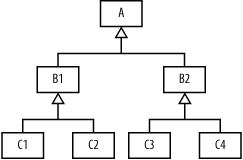Inheritance
You may have one or more inheritance hierarchies in your object model. JDO implementations provide an assortment of approaches for mapping the Java classes in an inheritance hierarchy into the nonhierarchical relational tables. To understand the different mapping alternatives that are available, consider the inheritance hierarchy in Figure 5-1.

Figure 5-1. Inheritance hierarchy to be mapped to tables
JDO implementations support one or more of the following mapping strategies:
Each class in the hierarchy has a separate table. With this approach, a separate table is used for each class: A, B1, B2, C1, C2, C3, C4. Each table contains only the fields from its associated class. To access all the fields of a C1 instance, including the fields inherited from A and B1, it is necessary to access the tables corresponding to A, B1, and C1. Accessing a B2 instance requires accessing A and B2.
With this approach, typically the primary keys for B1 and B2 are defined as foreign keys on A, the primary keys for C1 and C2 are defined as foreign keys on B1, and the primary keys for C3 and C4 are defined as foreign keys on B2.
Each class in the hierarchy has a separate table, but inherited fields are duplicated in the tables for each subclass. This approach avoids the need to access the tables for A and B1 when accessing an instance of C1; only C1 needs to be accessed. However, when you use this ...
Get Java Data Objects now with the O’Reilly learning platform.
O’Reilly members experience books, live events, courses curated by job role, and more from O’Reilly and nearly 200 top publishers.

